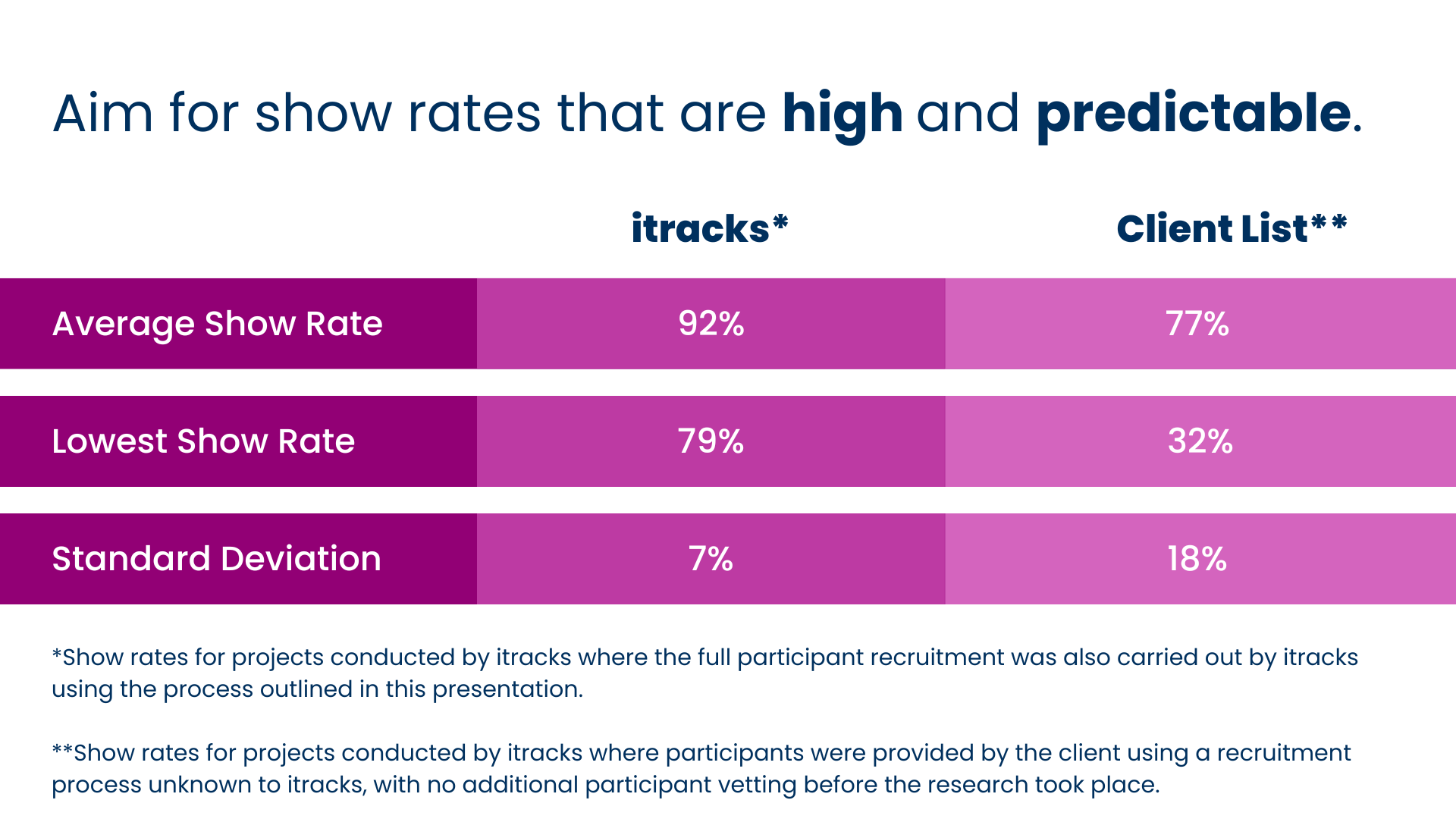ONLINE RECRUITING FOR QUALITATIVE RESEARCH
How to ensure authenticity, quality, and high show rates
By Adam Dumont, Rachel Gorman
Quality participants are fundamental to any qualitative research study, but finding them is easier said than done. With the rise of AI and people pretending to be who they’re not, now it is more important than ever to have a recruitment process that you can count on.
WHAT IS ONLINE RECRUITMENT?
Online qualitative recruitment is the process of finding, vetting, and preparing participants for an online qualitative research project. Your recruitment process should be designed to work regardless of where the participant sample originally comes from. Potential sources can include places such as online panels, web intercept, social media communications, client lists, and community or special interest groups.
WHAT TO AIM FOR
Successful participant recruitment will result in finding participants that:
- Fit study parameters. Participants should fit within the demographics or behaviors required in your study to provide you with the most accurate and useful information. They should also have access to the technology needed to participate.
- Are who they say they are. Look out for imposters! Due to the involvement of incentives for participation, some participants may misrepresent themselves in order to be selected. It is easy to falsify information online, particularly with AI easily accessible, meaning you need to be aware of how to identify fake information.
- Show up to your study. Once you have found the perfect participant, you want to ensure they show up to the research.
- Are engaged throughout. It is that participants show up technically, but also with the energy and attention needed in order to participate.
Failing any one of those four parameters could result in collecting incomplete or false data— something no one wants!
THE ITRACKS RECRUITMENT PROCESS
With these goals in mind, we can tailor our recruitment process for the best results.

1. A good screener will filter out unqualified participants, leaving you with those that have the most potential. Even if you have filtered for specific demographics in panel filters or through social media profiles, you should verify the demographics that are important to your study in the screener survey. It may be hard to tell when participants joined a panel or whether their social media profiles are up to date, but verifying their information through the survey should eliminate any uncertainty.
Including additional parameters in your survey can also reduce the amount of work needed later in the recruitment and research process. If you are looking for specific characteristics or behaviors in your participants, this stage is the best time to ask.
Keeping all that in mind, your screener also needs to accurately verify important information while keeping participant attention. Keeping the time to complete your screener to five minutes or less will increase your reach and likelihood of finding the best participants.
2. Re-screening and articulation is the most unique step in the itracks process, and the one most frequently skipped by other recruiters. Missing this step can lead to lower and inconsistent show rates. This step should weed out participants that may not be committed to your research, or may have provided false information in the screener survey. We use our itracks Board asynchronous platform for this step, but any platform where participants can login and upload a video will work.
During this step, look for consistency in participant responses and appearance. If their responses and appearance in the re-screening process don’t match the responses and demographics provided in the screener survey, they might not be providing accurate information.
Check engagement of your participants in the re-screener as well. Make sure your participants can engage at the level required for you to get the data needed for your study. Filling out a survey and participating in a focus group have different commitment levels, and your potential participants need to understand and commit to that.
Finally, you need to ensure that participants meet all the technological requirements needed to participate. Your perfect participant is not going to be able to provide you with the information you need if they are unable to relay those insights to you. Having participants upload a video of themselves into the research platform verifies that they have the necessary technology and capabilities required to participate in online research on the platform.
3. The effective use of invitations and reminders removes participant uncertainty from your project. While there is always the chance for sudden participant unavailability, you can reduce that potential with proper communication. Use channels and methods that are familiar to participants. If your demographic is used to email and will reliably check it then this might be the best mode of communication, whereas other demographics may be more comfortable with texting, WhatsApp, or phone communication.
Your initial communication should always include a calendar item that could be added to a participant’s digital calendar. This will make them more likely to remember to show up, and provides them a convenient place to store information about the focus group. itracks' email scheduler and templates allow you to include all of the pertinent calendar information in your communications to participants. Check the platform you’re using for options to include this automatically as well.
Remind participants (potentially more than once) before the study begins. If it’s an asynchronous study that requires ongoing participation, you may want to schedule automatic daily reminders for them as well. The more convenient you make it for participants to participate, the more likely they will do so.
4. Incentives are the number one reason participants will be interested in a study, and a good incentive can mean all the difference in attracting quality participants. Whatever the size and type of incentives, make sure that you:
-
- Communicate the details clearly at the beginning of the process
- Include clear details as to what is required of the participant to receive the incentive
- Include the expected timeline of incentive distribution
You also want to ensure that the amount of incentive you offer is appropriate for the audience you’re targeting, and for the amount of work involved in the study. Harder to reach populations or certain demographics may require a larger sum to participate. Too high of an incentive can promote fraudulent behavior, but too low of an incentive can reduce response rates.
With these four steps in mind, you will be well on your way to reaching the best participants through your recruitment process.
Have any questions or want to get started on your online qualitative research project? Contact us!
